Early Triassic Conversion from Source to Sink on the Southern Margin of the North China Craton: Constraints by Detrital Zircon U-Pb Ages
Abstract
1. Introduction
2. Geological Setting
3. Sampling and Analytical Methods
4. Results
4.1. Sandstone Detrital Compositions
4.2. Detrital Zircon U-Pb Ages
5. Discussion
5.1. Potential Source Area Age Signatures
5.2. Provenance Analysis of the Early Triassic Strata
5.2.1. Provenances of the Liujiagou Formation
5.2.2. Provenances of the Heshanggou Formation
5.3. Constraints on the Paleogeographic and Tectonic Evolution
5.4. Conversion of the Source-To-Sink System
6. Conclusions
Supplementary Materials
Author Contributions
Funding
Acknowledgments
Conflicts of Interest
References
- Liu, S.F.; Zhang, G.W. Fundamental ideas, contents and methods in study of basin and mountain relationships. Earth Sci. Front. 2005, 12, 101–111. (In Chinese) [Google Scholar]
- Wu, L.L.; Mei, L.F.; Liu, Y.S.; Luo, J.; Min, C.Z.; Lu, S.L.; Li, M.H.; Guo, L.B. Multiple provenance of rift sediments in the composite basin-mountain system: Constraints from detrital zircon U-Pb geochronology and heavy minerals of the early Eocene Jianghan Basin, central China. Sediment. Geol. 2017, 349, 46–61. [Google Scholar] [CrossRef]
- Zhou, W.Y.; Jiao, Y.Q.; Zhao, J.H. Sediment provenance of the intracontinental Ordos Basin in North China Craton controlled by tectonic evolution of the basin-orogen system. J. Geol. 2017, 125, 701–711. [Google Scholar] [CrossRef]
- Yang, W.T.; Wang, M.; Zheng, D.S.; Du, Y.S. Late Triassic sedimentary record from the Nanzhao Basin and implications for the orogeny in the Qinling Orogenic Belt, central China. J. Asian Earth Sci. 2018, 166, 120–135. [Google Scholar] [CrossRef]
- Cawood, P.A.; Hawkesworth, C.J.; Dhuime, B. Detrital zircon record and tectonic setting. Geology 2012, 40, 875–878. [Google Scholar] [CrossRef]
- Gehrels, G. Detrital zircon U-Pb geochronology applied to tectonics. Annu. Rev. Earth Planet. Sci. 2014, 42, 127–149. [Google Scholar] [CrossRef]
- Yang, W.T.; Yang, J.H.; Wang, X.F.; Du, Y.S. Uplift-denudation history of the Qinling orogen: Constrained from the detrital-zircon U-Pb geochronology. J. Asian Earth Sci. 2014, 89, 54–65. [Google Scholar] [CrossRef]
- Zhu, X.Q.; Zhu, W.B.; Ge, R.F.; Wang, X. Late Paleozoic provenance shift in the south-central North China Craton: Implications for tectonic evolution and crustal growth. Gondwana Res. 2014, 25, 383–400. [Google Scholar] [CrossRef]
- Yang, D.B.; Yang, H.T.; Shi, J.P.; Xu, W.L.; Wang, F. Sedimentary response to the paleogeographic and tectonic evolution of the southern North China Craton during the late Paleozoic and Mesozoic. Gondwana Res. 2017, 49, 278–295. [Google Scholar] [CrossRef]
- Liu, S.F.; Su, S.; Zhang, G.W. Early Mesozoic basin development in North China: Indiacations of cratonic deformation. J. Asian Earth Sci. 2013, 62, 221–236. [Google Scholar] [CrossRef]
- Liu, Y.Q.; Kuang, H.W.; Peng, N.; Xu, H.; Zhang, P.; Wang, N.S.; An, W. Mesozoic basins and associated palaeogeographic evolution in North China. J. Palaeogeogr. 2015, 4, 189–202. [Google Scholar] [CrossRef]
- Wang, Y.; Zhou, L.Y.; Liu, S.F.; Li, J.Y.; Yang, T.N. Post-cratonization deformation processes and tectonic evolution of the North China Craton. Earth-Sci. Rev. 2018, 177, 320–365. [Google Scholar] [CrossRef]
- Meng, Q.R.; Wu, G.L.; Fan, L.G.; Wei, H.H. Tectonic evolution of early Mesozoic sedimentary basins in the North China block. Earth-Sci. Rev. 2019, 190, 416–439. [Google Scholar] [CrossRef]
- Pan, G.T.; Lu, S.N.; Xiao, Q.H.; Zhang, K.X.; Yin, F.G.; Hao, G.J.; Luo, M.S.; Ren, F.; Yuan, S.H. Division of tectonic stages and tectonic evolution in China. Earth Sci. Front. 2016, 23, 1–23. (In Chinese) [Google Scholar]
- Li, S.Z.; Jahn, B.M.; Zhao, S.J.; Dai, L.M.; Li, X.Y.; Suo, Y.H.; Guo, L.L.; Wang, Y.M.; Liu, X.C.; Lan, H.Y.; et al. Triassic southeastward subduction of North China Block to South China Block: Insights from new geological, geophysical and geochemical data. Earth-Sci. Rev. 2017, 166, 270–285. [Google Scholar] [CrossRef]
- Zhao, Y.; Zhai, M.G.; Chen, H.; Zhang, S.H. Paleozoic-early Jurassic tectonic evolution of North China Craton and its adjacent orogenic belts. Geol. China 2017, 44, 44–60. (In Chinese) [Google Scholar]
- Li., H.Y.; He, B.; Xu, Y.G.; Huang, X.L. U–Pb and Hf isotope analyses of detrital zircons from Late Paleozoic sediments: Insights into interactions of the North China Craton with surrounding plates. J. Asian Earth Sci. 2010, 39, 335–346. [Google Scholar] [CrossRef]
- Zhu, R.X.; Yang, J.H.; Wu, F.Y. Timing of destruction of the North China Craton. Lithos 2012, 149, 51–60. [Google Scholar] [CrossRef]
- Chen, S.Y. The basin-range coupling in southern North China block during the Late Palaeozoic to Triassic. Sedimentary Geol. Tethyan Geol. 2000, 20, 37–43. (In Chinese) [Google Scholar]
- Chen, S.Y. Sedimentary-tectonic evolution from Late Paleozoic to Triassic in the south of North China Block. J. China Univ. Min. Technol. 2000, 29, 536–540. (In Chinese) [Google Scholar]
- Liu, S.F.; Zhang, G.W. Evolution and geodynamics of basin/mountain systems in East Qinling Dabieshan and its adjacent regions, China. Geol. Bull. China 2008, 27, 1943–1960. (In Chinese) [Google Scholar]
- Dong, Y.P.; Santosh, M. Tectonic architecture and multiple orogeny of the Qinling Orogenic Belt, Central China. Gondwana Res. 2016, 29, 1–40. [Google Scholar] [CrossRef]
- Meng, X.H.; Zhang, Y.; Wang, D.Y.; Zhang, X. Provenance analysis of the Late Triassic Yichuan Basin: Constraints from zircon U-Pb geochronology. Open Geosci. 2018, 10, 34–44. [Google Scholar] [CrossRef]
- Wilde, S.A.; Zhou, J.B. The late Paleozoic to Mesozoic evolution of the eastern margin of the Central Asian Orogenic Belt in China. J. Asian Earth Sci. 2015, 113, 909–921. [Google Scholar] [CrossRef]
- Liu, Y.J.; Li, W.M.; Feng, Z.Q.; Wen, Q.B.; Neubauer, F.; Liang, C.Y. A review of the Paleozoic tectonics in the eastern part of Central Asian Orogenic Belt. Gondwana Res. 2017, 43, 123–148. [Google Scholar] [CrossRef]
- Dong, Y.P.; Liu, X.M.; Neubauer, F.; Zhang, G.W.; Tao, N.; Zhang, Y.G.; Zhang, X.N.; Li, W. Timing of Paleozoic amalgamation between the North China and South China Blocks: Evidence from detrital zircon U-Pb ages. Tectoniphysics 2013, 586, 173–191. [Google Scholar] [CrossRef]
- Zhang, L.W.; Yao, J.X.; Niu, Y.B. The genesis of conglomerate in Lower Triassic Liujiagou Formation of western Henan province. Geol. Bull. China 2017, 36, 1056–1063. (In Chinese) [Google Scholar]
- Chu, D.L.; Tong, J.N.; Bottjer, D.J.; Song, H.J.; Song, H.Y.; Benton, M.J.; Tian, L.; Guo, W.W. Microbial mats in the terrestrial Lower Triassic of North China and implications for the Permian–Triassic mass extinction. Palaeogeogr. Palaeoclim. Palaeoecol 2017, 474, 214–231. [Google Scholar] [CrossRef]
- Dickinson, W.R.; Suczek, C.A. Plate tectonics and sandstone compositions. Am. Assoc. Pet. Geol. Bull. 1979, 63, 2164–2182. [Google Scholar]
- Dickinson, W.R. Interpreting provenance relations from detrital modes of sandstone. Springer 1985, 148, 333–361. [Google Scholar]
- Bureau of Geology and Mineral Resources of Henan Province. Regional Geology of Henan Provinc; Geological Publishing House: Beijing, China, 1989. (In Chinese) [Google Scholar]
- Liu, Y.S.; Hu, Z.C.; Gao, S.; Günther, D.; Xu, J.; Gao, C.G.; Chen, H.H. In situ analysis of major and trace elements of anhydrous minerals by LA-ICP-MS without applying an internal standard. Chem. Geol. 2008, 257, 34–43. [Google Scholar] [CrossRef]
- Ludwig, K.R. ISOPLOT 3.00: A Geochronological Toolkit for Microsoft Excel; Berkeley Geochronology Center: Berkeley, CA, USA, 2003; p. 39. [Google Scholar]
- Sircombe, K.N. Tracing provenance through the isotope ages of littoral and sedimentary detrital zircon, eastern Australia. Sediment. Geol. 1999, 124, 47–67. [Google Scholar] [CrossRef]
- Hoskin, P.W.; Schaltegger, U. The composition of zircon and igneous and metamorphic petrogenesis. Rev. Mineral. Geochem. 2003, 53, 27–62. [Google Scholar] [CrossRef]
- Wu, Y.B.; Zheng, Y.F. Genesis of zircon and its constraints on interpretation of U-Pb age. Chin. Sci. Bull. 2004, 49, 1554–1569. [Google Scholar] [CrossRef]
- Zhai, M.G.; Santosh, M. The early Precambrian odyssey of North China Craton: A synoptic overview. Gandwana Res. 2011, 20, 6–25. [Google Scholar] [CrossRef]
- Wan, Y.S.; Dong, C.Y.; Liu, D.Y.; Kroner, A.; Yang, C.H.; Wang, W.; Du, L.L.; Xie, H.Q.; Ma, M.Z. Zircon ages and geochemistry of late Neoarchean syenogranites in the North China Craton: A review. Precambr. Res. 2012, 222, 265–289. [Google Scholar] [CrossRef]
- Zhao, G.C.; Zhai, M.G. Lithotectonic elements of Precambrian basement in the North China Craton: Review and tectonic implications. Gondwana Res. 2013, 23, 1207–1240. [Google Scholar] [CrossRef]
- Santosh, M.; Teng, X.M.; He, X.F.; Tang, L.; Yang, Q.Y. Discovery of Neoarchean suprasubduction zone ophiolite suite from Yishui Complex in the North China Craton. Gondwana Res. 2016, 38, 1–27. [Google Scholar] [CrossRef]
- Diwu, C.R.; Sun, Y.; Guo, A.L.; Wang, H.L.; Liu, X.M. Crustal growth in the North China Craton at ~2.5 Ga: Evidence from in situ zircon U-Pb ages, Hf isotopes and whole-rock geochemistry of the Dengfeng complex. Gondwana Res. 2011, 20, 149–170. [Google Scholar] [CrossRef]
- Diwu, C.R.; Sun, Y.; Wang, Q. The crustal growth and evolution of North China Craton: Revealed by Hf isotopes in detrital zircons from modern rivers. Acta Petrol. Sin. 2012, 28, 3520–3530. [Google Scholar]
- Zhao, G.C.; Wilde, S.A.; Guo, J.H.; Cawood, P.A.; Sun, M.; Li, X.P. Single zircon grains record two continental collisional events in the North China craton. Precambr. Res. 2010, 177, 266–276. [Google Scholar] [CrossRef]
- Zhao, G.C.; Cawood, P.A.; Li, S.Z.; Wilde, S.A.; Sun, M.; Zhang, J.; He, Y.H.; Yin, C.Q. Amalgamation of the North China Craton: Key issues and discussion. Precambr. Res. 2012, 222, 55–76. [Google Scholar] [CrossRef]
- Yang, Q.Y.; Santosh, M. Paleoproterozoic arc magmatism in the North China Craton: No Siderian global plate tectonic shutdown. Gondwana Res. 2015, 28, 82–105. [Google Scholar] [CrossRef]
- Yang, Q.Y.; Santosh, M. Charnockite magmatism during a transitional phase: Implications for Late Paleoproterozoic ridge subduction in the North China Craton. Precambr. Res. 2015, 261, 188–216. [Google Scholar] [CrossRef]
- Wang, X.X.; Wang, T.; Zhang, C.L. Neoproterozoic, Paleozoic, and Mesozoic granitoid magmatism in the Qinling Orogen, China: Constraints on orogenic process. J. Asian Earth Sci. 2013, 72, 129–151. [Google Scholar] [CrossRef]
- Dong, Y.P.; Yang, Z.; Liu, X.M.; Zhang, X.N.; He, D.F.; Li, W.; Zhang, F.F.; Sun, S.S.; Zhang, H.F.; Zhang, G.W. Neoproterozoic amalgamation of the Northern Qinling terrain to the North China Craton: Constraints from geochronology and geochemistry of the Kuanping ophiolite. Precambr. Res. 2014, 255, 77–95. [Google Scholar] [CrossRef]
- Dong, Y.P.; Zhang, X.N.; Liu, X.M.; Li, W.; Chen, Q.; Zhang, G.W.; Zhang, H.F.; Yang, Z.; Sun, S.S.; Zhang, F.F. Propagation tectonics and multiple accretionary processes of the Qinling Orogen. J. Asian Earth Sci. 2015, 104, 84–98. [Google Scholar] [CrossRef]
- Liu, R.Y.; Niu, B.G.; He, Z.J.; Ren, J.S. LA-ICP-MS zircon U-Pb geochronology of the eastern part of the Xiaomaoling composite intrusives in Zhashui area, Shansnxi, China. Geol. Bull. China 2011, 30, 448–460. [Google Scholar]
- Zhang, R.Y.; Sun, Y.; Zhang, X.; Ao, W.H.; Santosh, M. Neoproterozoic magmatic events in the South Qinling Belt, China: Implications for amalgamation and breakup of the Rodinia supercontinent. Gondwana Res. 2016, 30, 6–23. [Google Scholar] [CrossRef]
- Zhao, S.J.; Li, S.Z.; Liu, X.; Santosh, M.; Somerville, I.D.; Cao, H.H.; Yu, S.; Zhang, Z.; Guo, L.L. The northern boundary of the Proto-Tethys Ocean: Constraints from structural analysis and U-Pb zircon geochronology of the North Qinling Terrane. J. Asian Earth Sci. 2015, 113, 560–574. [Google Scholar] [CrossRef]
- Shi, Y.; Yu, J.H.; Santosh, M. Tectonic evolution of the Qinling orogenic belt, Central China: New evidence from geochemical, zircon U-Pb geochronology and Hf isotopes. Precambr. Res. 2013, 231, 19–60. [Google Scholar] [CrossRef]
- Diwu, C.R.; Sun, Y.; Zhao, Y.; Liu, B.X.; Lai, S.C. Geochronological, geochemical, and Nd-Hf isotopic studies of the Qinling Complex, central China: Implications for the evolutionary history of the North Qinling Orogenic Belt. Geosci. Front. 2014, 5, 499–513. [Google Scholar] [CrossRef]
- Liao, X.Y.; Wang, Y.W.; Liu, L.; Wang, C.; Santosh, M. Detrital zircon U-Pb and Hf isotopic data from the Liuling Group in the South Qinling belt: Provenance and tectonic implications. J. Asian Earth Sci. 2017, 134, 244–261. [Google Scholar] [CrossRef]
- Zhang, C.L.; Liu, L.; Wang, T.; Wang, X.X.; Li, L.; Gong, Q.F.; Li, X.F. Granitic magmatism related to early Paleozoic continental collision in North Qinling. Chin. Sci. Bull. 2013, 58, 4405–4410. [Google Scholar] [CrossRef]
- Dong, Y.P.; Zhang, G.W.; Neubauer, F.; Liu, X.M.; Genser, J.; Hauzenberger, C. Tectonic evolution of the Qinling orogen, China: Review and synthesis. J. Asian Earth Sci. 2011, 41, 213–237. [Google Scholar] [CrossRef]
- Zhang, S.H.; Zhao, Y.; Song, B.; Yang, Y.H. Zircon SHRIMP U-Pb and in-situ Lu-Hf isotope analyses of a tuff from western Beijing: Evidence for missing late Paleozoic arc volcano eruptions at the northern margin of the North China block. Gondwana Res. 2007, 12, 157–165. [Google Scholar] [CrossRef]
- Zhang, S.H.; Zhao, Y.; Song, B.; Hu, J.M.; Liu, S.W.; Yang, Y.H.; Chen, F.K.; Liu, X.M.; Liu, J. Contrasting Late Carboniferous and Late Permian-Middle Triassic intrusive suites from the northern margin of the North China craton: Geochronology, petrogenesis and tectonic implications. Geol. Soc. Am. Bull. 2009, 121, 181–200. [Google Scholar] [CrossRef]
- Zhang, S.H.; Zhao, Y.; Liu, J.M.; Hu, Z.C. Different sources involved in generation of continental arc volcanism: The Carboniferous-Permian volcanic rocks in the northern margin of the North China block. Lithos 2016, 240, 382–401. [Google Scholar] [CrossRef]
- Zhang, S.H.; Zhao, Y.; Liu, J.M.; Hu, J.M.; Song, B.; Liu, J.; Wu, H. Geochronology, geochemistry and tectonic setting of the Late Paleozoic-Early Mesozoic magmatism in the northern margin of the North China Block: A preliminary review. Acta Petrol. Et Mineral. 2010, 29, 824–842. (In Chinese) [Google Scholar]
- Ma, S.X.; Meng, Q.R.; Duan, L.; Wu, G.L. Reconstructing Late Paleozoic exhumation history of the Inner Mongolia Highland along the northern edge of the North China Craton. J. Asian Earth Sci. 2014, 87, 89–101. [Google Scholar] [CrossRef]
- Yang, J.H.; Wu, F.Y.; Shao, J.A.; Wilde, S.A.; Xie, L.W.; Liu, S.M. Constraints on the timing of uplift of the Yanshan Fold and Thrust Belt, North China. Earth Planet. Sci. Lett. 2006, 246, 336–352. [Google Scholar] [CrossRef]
- Cope, T. Phanerozoic magmatic tempos of North China. Earth Planet. Sci. Lett. 2017, 468, 1–10. [Google Scholar] [CrossRef]
- Xie, X.Y. Provenance and sediment dispersal of the Triassic Yanchang Formation, southwest Ordos Basin, China, and its implications. Sediment. Geol. 2016, 335, 1–16. [Google Scholar] [CrossRef]
- Xie, D.N. Tectono-sedimentary evolution since the Late Paleozoic and natural gas formation in the southern North-China Basin. Ph.D. Thesis, Northwest University, Xi’an, China, 2007. (In Chinese). [Google Scholar]
- Meng, Q.R.; Wei, H.H.; Wu, G.L.; Duan, L. Early Mesozoic tectonic settings of the northern North China craton. Tectonophysics 2014, 611, 155–166. [Google Scholar] [CrossRef]
- Zhou, R.; Liu, D.N.; Zhou, A.C.; Zou, Y. Provenance analyses of early Mesozoic sediments in the Ningwu basin: Implications for the tectonic-palaeogeographic evolution of the northcentral North China Craton. Int. Geol. Rev. 2019, 61, 86–108. [Google Scholar] [CrossRef]
- Liu, C.; Sun, B.L.; Zeng, F.G. Constraints on U-Pb dating of detrital zircon of the maximum depositional age for Upper Permian to Lower Triassic strata in Xishan, Taiyuan. Acta Geol. Sin. 2014, 88, 1579–1587. (In Chinese) [Google Scholar]
- Bao, C.; Chen, Y.L.; Li, D.P.; Wang, S.H. Provenances of the Mesozoic sediments in the Ordos Basin and implications for collision between the North China Craton (NCC) and the South China Craton (SCC). J. Asian Earth Sci. 2014, 96, 296–307. [Google Scholar]
- Peng, S.Y.; Yang, W.T.; Wang, Y.P.; Zhong, C.C. Detrital zircon Chronology of the Lower-Middle Triassic strata in Jiyuan Area and its implication for provenance analysis. Geol. Sci. Technol. Inf. 2019, 38, 126–137. (In Chinese) [Google Scholar]
- Zhao, T.P.; Zhai, M.G.; Xia, B.; Li, H.M.; Zhang, Y.X.; Wan, Y.S. Zircon U-Pb SHRIMP dating for the volcanic rocks of the Xiong’er Group: Constraints on the initial formation age of the cover of the North China Craton. Chin. Sci. Bull. 2004, 49, 2495–2502. [Google Scholar] [CrossRef]
- Zheng, J.P.; Griffin, W.L.; O’Reily, S.Y.; Lu, F.X.; Wang, C.Y.; Zhang, M.; Wang, F.Z.; Li, H.M. 3.6 Ga lower crust in central China: New evidence on the assembly of the North China craton. Geology 2004, 32, 229–232. [Google Scholar] [CrossRef]
- Xu, X.S.; Griffin, W.L.; Ma, X.; O’Reilly, S.Y.; He, Z.Y.; Zhang, C.L. The Taihua group on the southern margin of the North China craton: Further insights from U–Pb ages and Hf isotope compositions of zircons. Mineral. Petrol. 2009, 97, 43–59. [Google Scholar] [CrossRef]
- Cui, M.L.; Zhang, B.L.; Zhang, L.C. U–Pb dating of baddeleyite and zircon from the Shizhaigou diorite in the southern margin of North China Craton: Constrains on the timing and tectonic setting of the Paleoproterozoic Xiong’er group. Gondwana Res. 2011, 20, 184–193. [Google Scholar] [CrossRef]
- Zhou, Y.Y.; Zhao, T.P.; Wang, C.Y.; Hu, G.H. Geochronology and geochemistry of 2.5 to 2.4 Ga granitic plutons from the southern margin of the North China Craton: Implications for a tectonic transition from arc to post-collisional setting. Gondwana Res. 2011, 20, 171–183. [Google Scholar] [CrossRef]
- Wang, Y.P.; Yang, W.T.; Zheng, D.S.; Zuo, P.F.; Qi, S.S. Detrital zircon U-Pb ages from the Middle to Late Permian strata of the Yiyang area, southern North China Craton: Implications for the Mianlue oceanic crust subduction. Geol. J. 2019, 54, 3527–3541. [Google Scholar] [CrossRef]
- Zhu, X.Y.; Chen, F.K.; Li, S.Q.; Yang, Y.Z.; Nie, H.; Siebel, W.G.; Zhai, M.G. Crustal evolution of the North Qinling terrain of the Qinling Orogen, China: Evidence from detrital zircon U-Pb ages and Hf isotopic composition. Gondwana Res. 2011, 20, 194–204. [Google Scholar] [CrossRef]
- Cao, H.H.; Li, S.Z.; Zhao, S.J.; Yu, S.; Li, X.B.; Somerville, I.D. Detrital zircon geochronology of Neoproterozoic to early Paleozoic sedimentary rocks in the North Qinling Orogenic Belt: Implications for the tectonic evolution of the Kuanping Ocean. Precambr. Res. 2016, 279, 1–16. [Google Scholar] [CrossRef]
- Wang, Q.F.; Deng, J.; Liu, X.F.; Cai, S.H. Provenance of Late Carboniferous bauxite deposits in the North China Craton: New constraints on marginal arc construction and accretion processes. Gondwana Res. 2016, 38, 86–98. [Google Scholar] [CrossRef]
- Zhang, S.H.; Zhao, Y.; Song, B. Hornblende thermobarometry of the Carboniferous granitoids from the Inner Mongolia Paleo-uplift: Implications for the tectonic evolution of the northern margin of North China block. Mineral. Petrol. 2006, 87, 123–141. [Google Scholar] [CrossRef]
- Deng, Z.B.; Liu, S.W.; Zhang, W.Y.; Hu, F.Y.; Li, Q.G. Petrogenesis of the Guangtoushan Granitoid Suite, Central China: Implications for Early Mesozoic geodynamic evolution of the Qinling Orogenic Belt. Gondwana Res. 2016, 30, 112–131. [Google Scholar] [CrossRef]
- Zhou, Z.J.; Mao, S.D.; Chen, Y.J.; Santosh, M. U–Pb ages and Lu–Hf isotopes of detrital zircons from the southern Qinling Orogen: Implications for Precambrian to Phanerozoic tectonics in central China. Gondwana Res. 2016, 35, 323–337. [Google Scholar] [CrossRef]
- Wang, M.; Guo, W.F.; Yang, W.T. Detrital zircon trace elements from the Mesozoic Jiyuan Basin, central China and its implication on tectonic transition of the Qinling Orogenic Belt. Open Geosci. 2019, 11, 125–139. [Google Scholar] [CrossRef]
- Zheng, C.; Li, B.F.; Wen, X.D. Depositional characteristics of the late Permian braided channel-braided delta deposits in northern foothills of the Qinling Mountains, China. Geoscience 2003, 17, 415–420. (In Chinese) [Google Scholar]
- Yang, W.T.; Wang, M.; Du, Y.S. The Depositional characteristics from Mesozoic Jiyuan Basin with its response to the uplift of Qinling Orogen and Thaihang Mountains. Geol. Rev. 2014, 60, 260–274. (In Chinese) [Google Scholar]
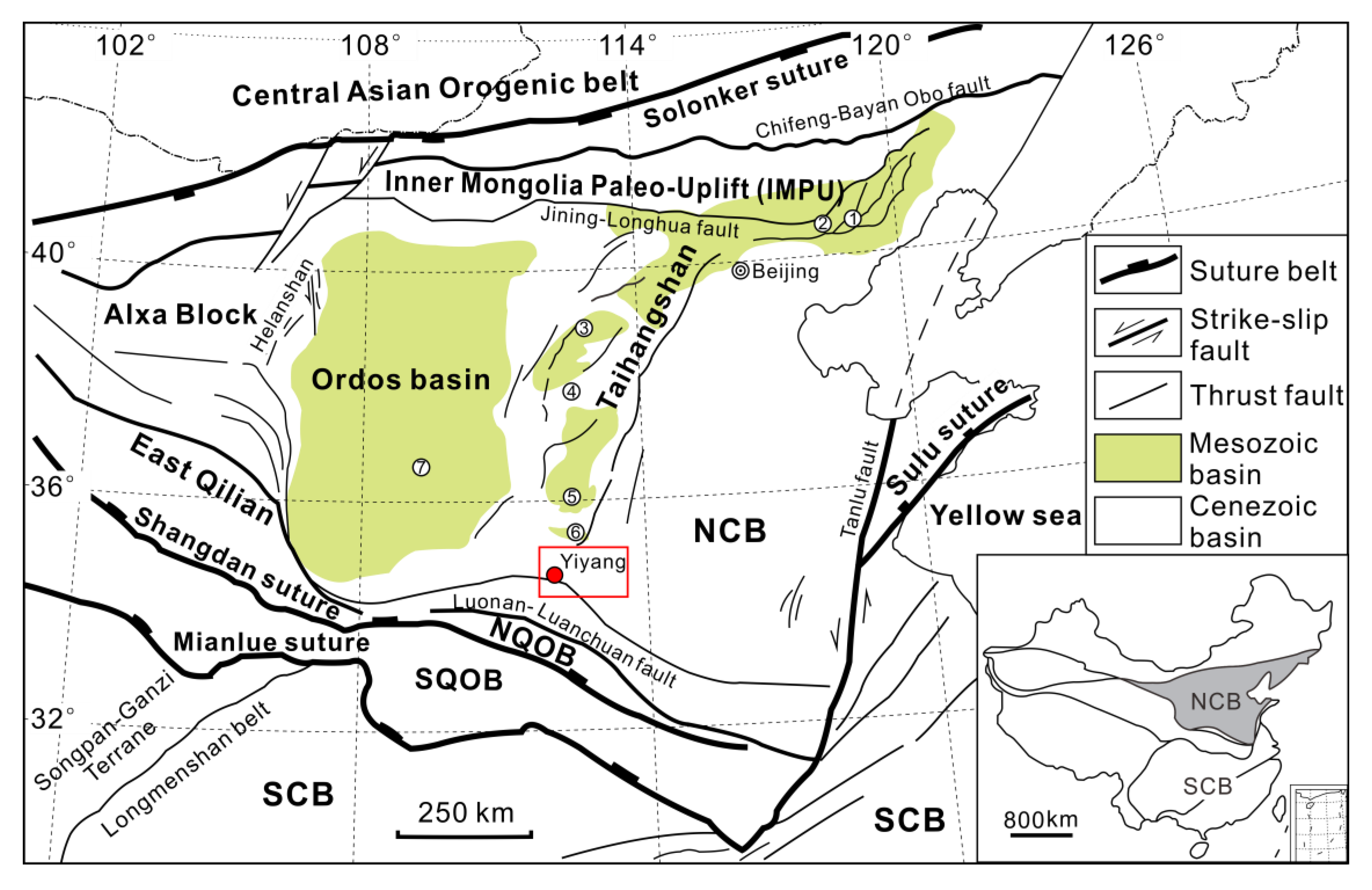
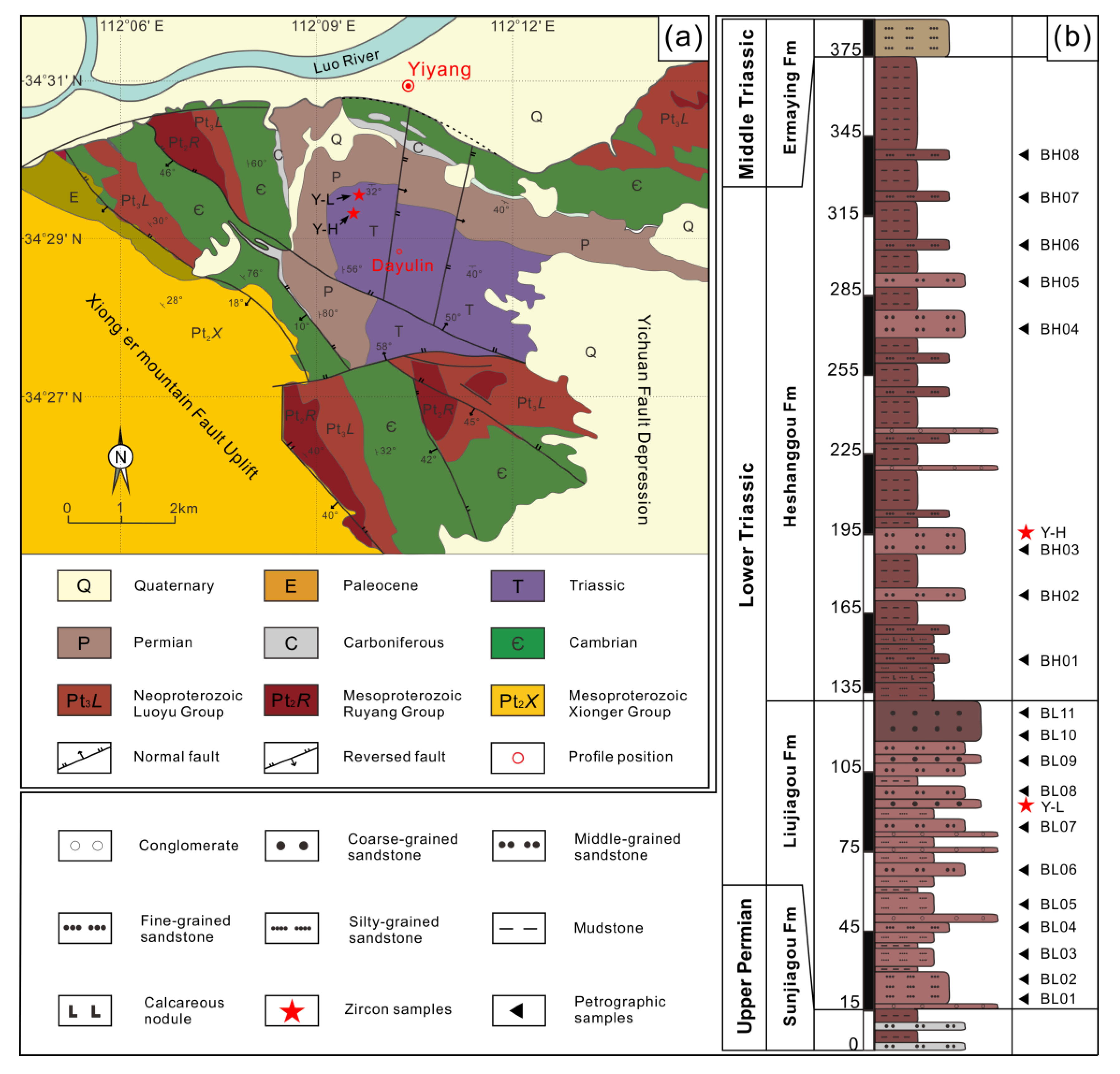
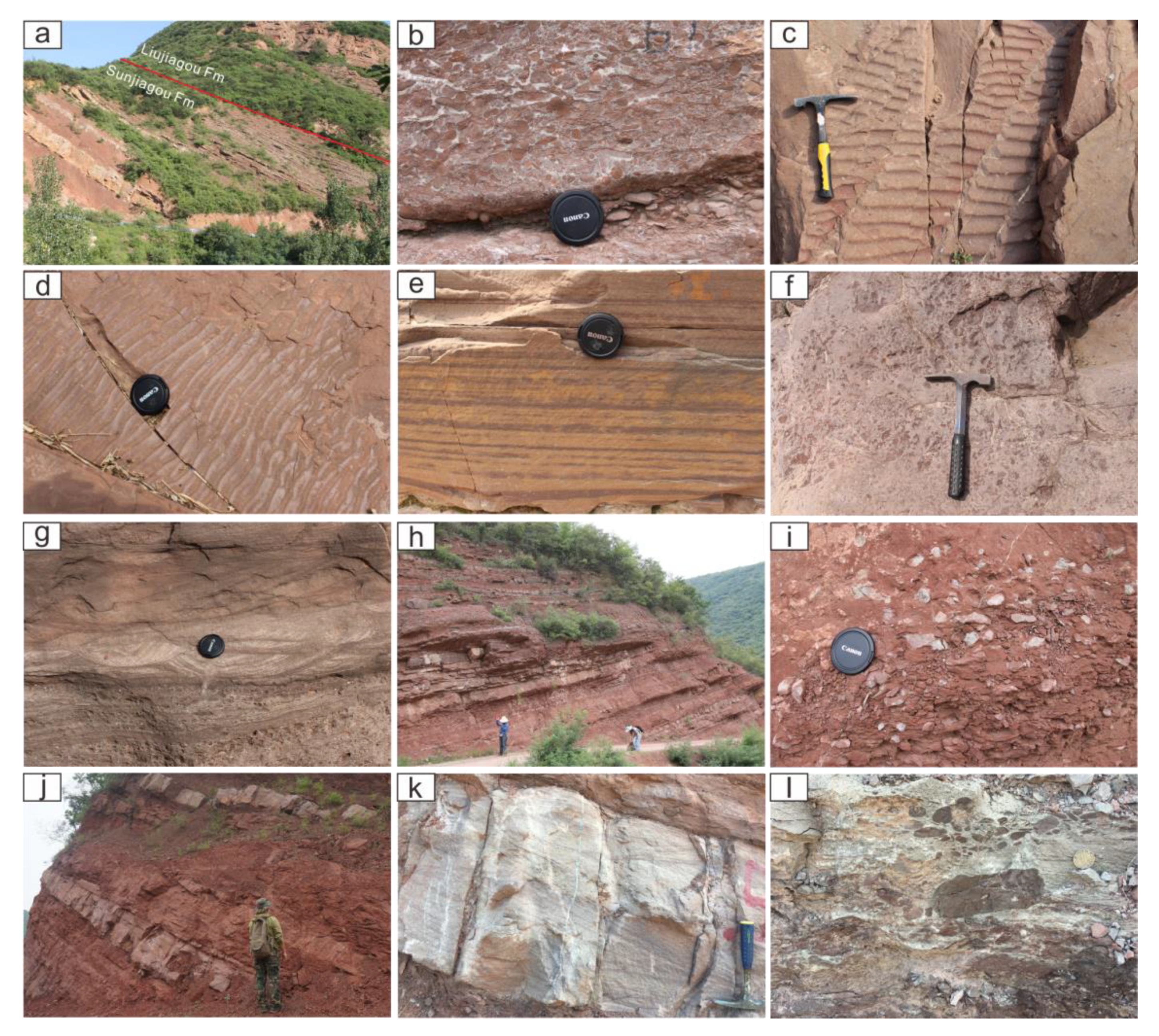
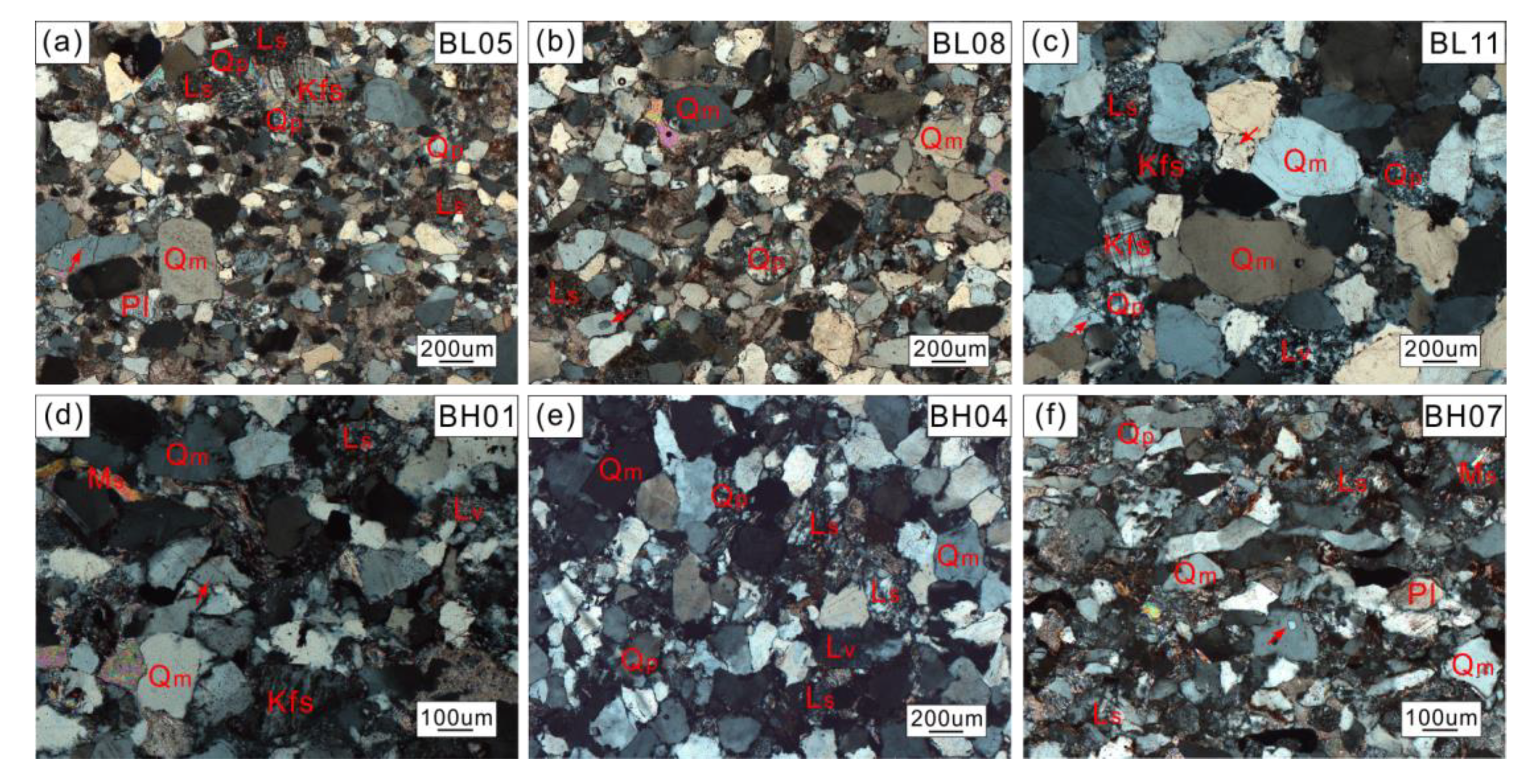
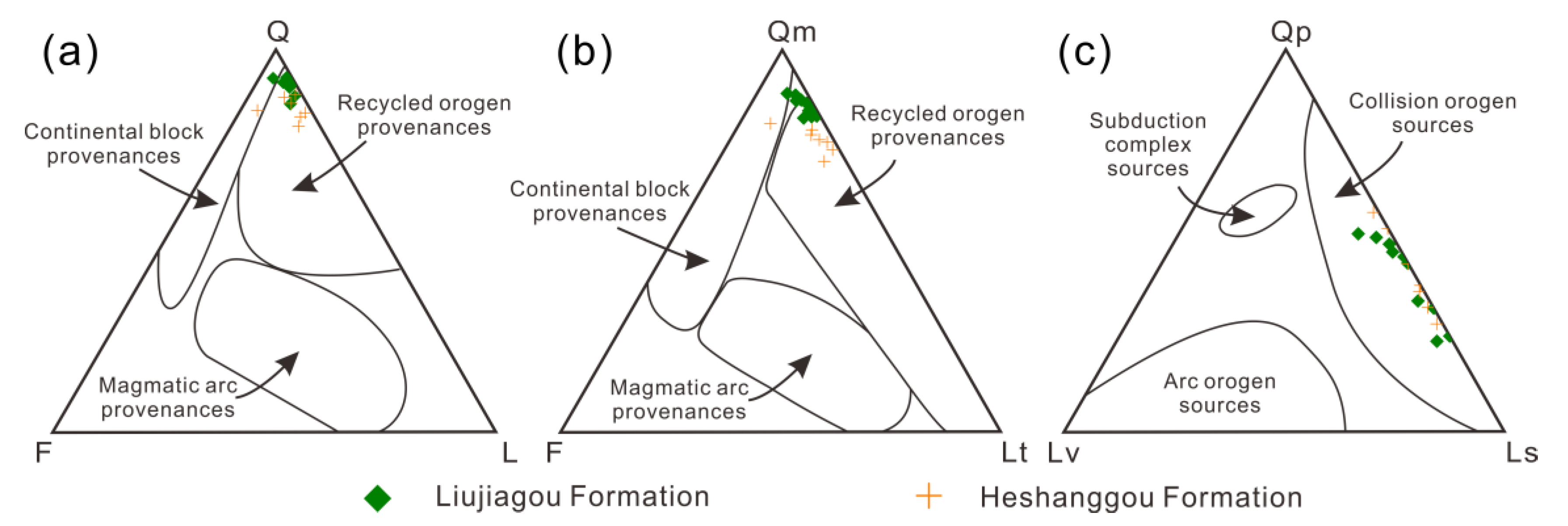
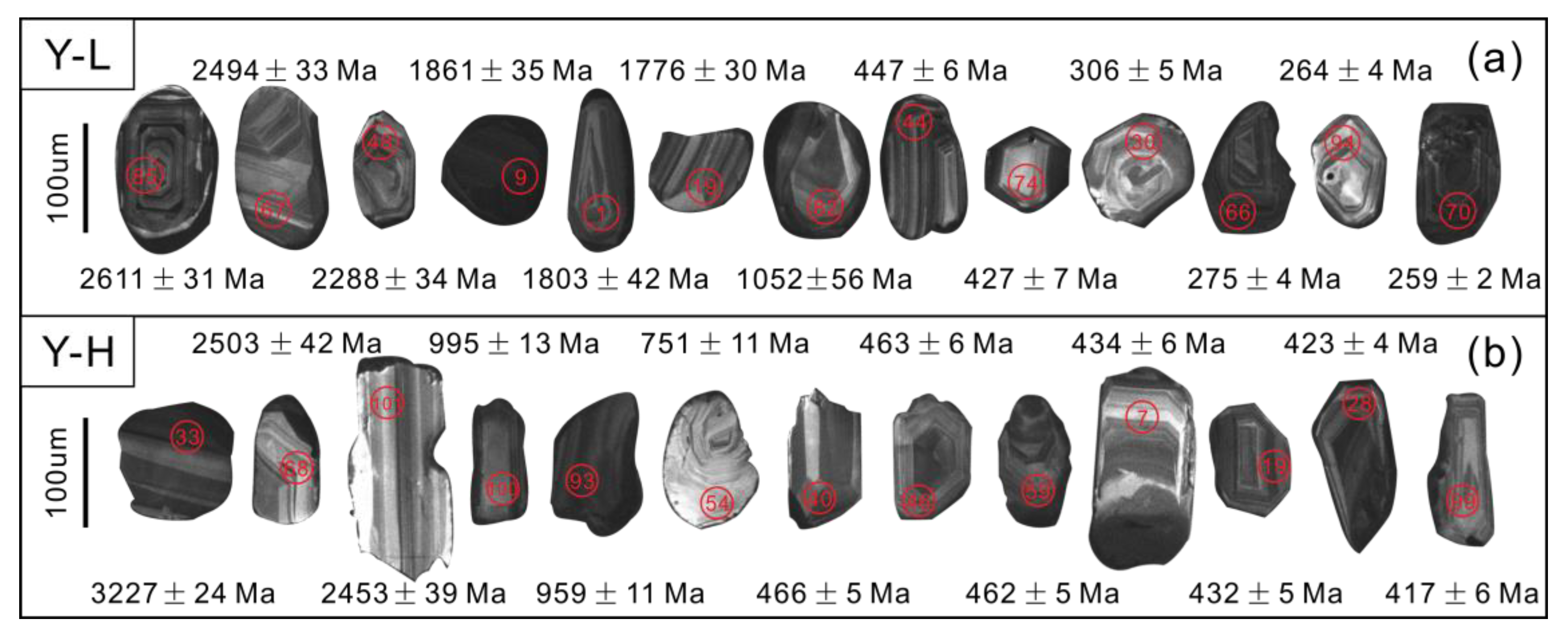
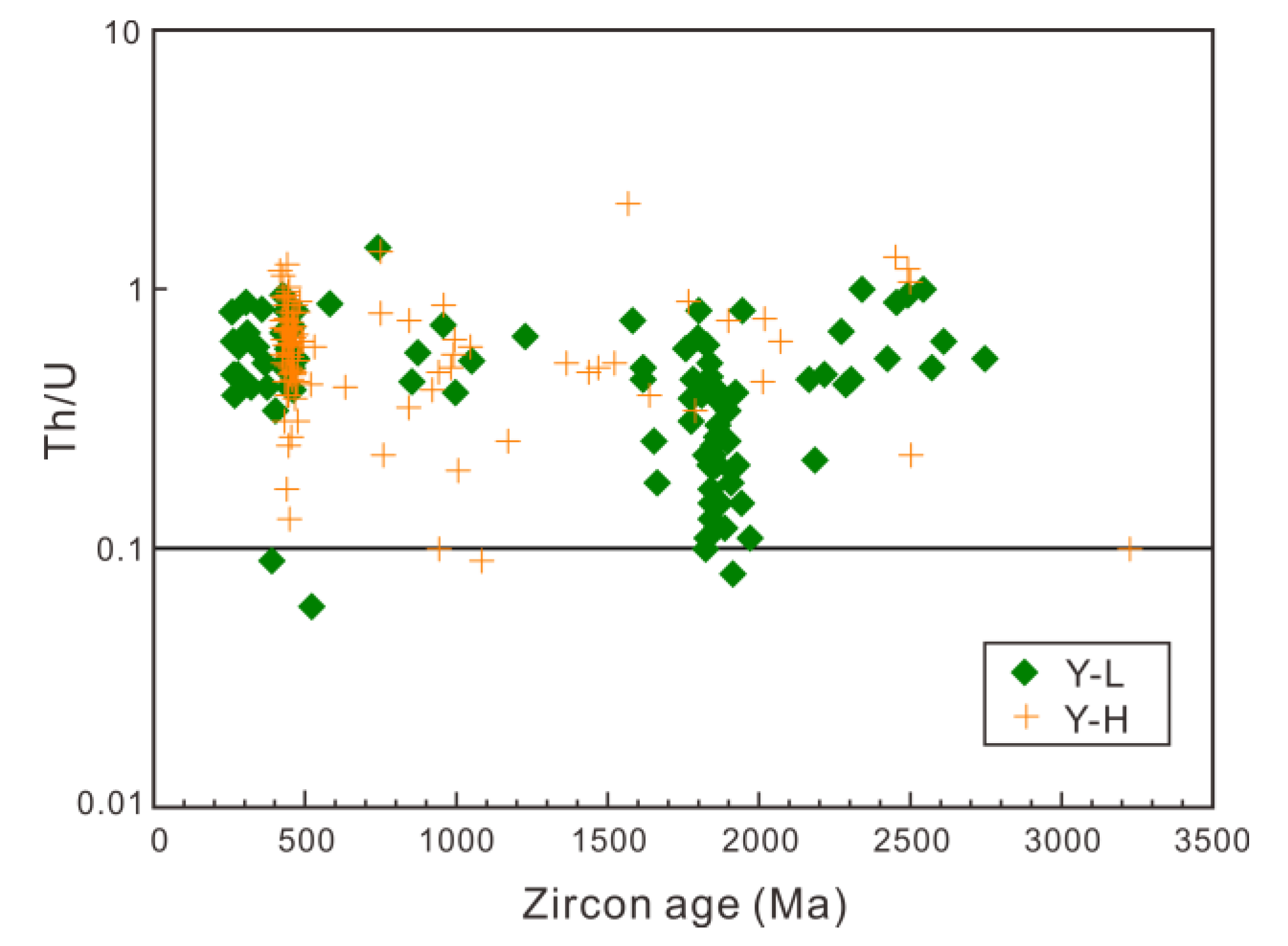
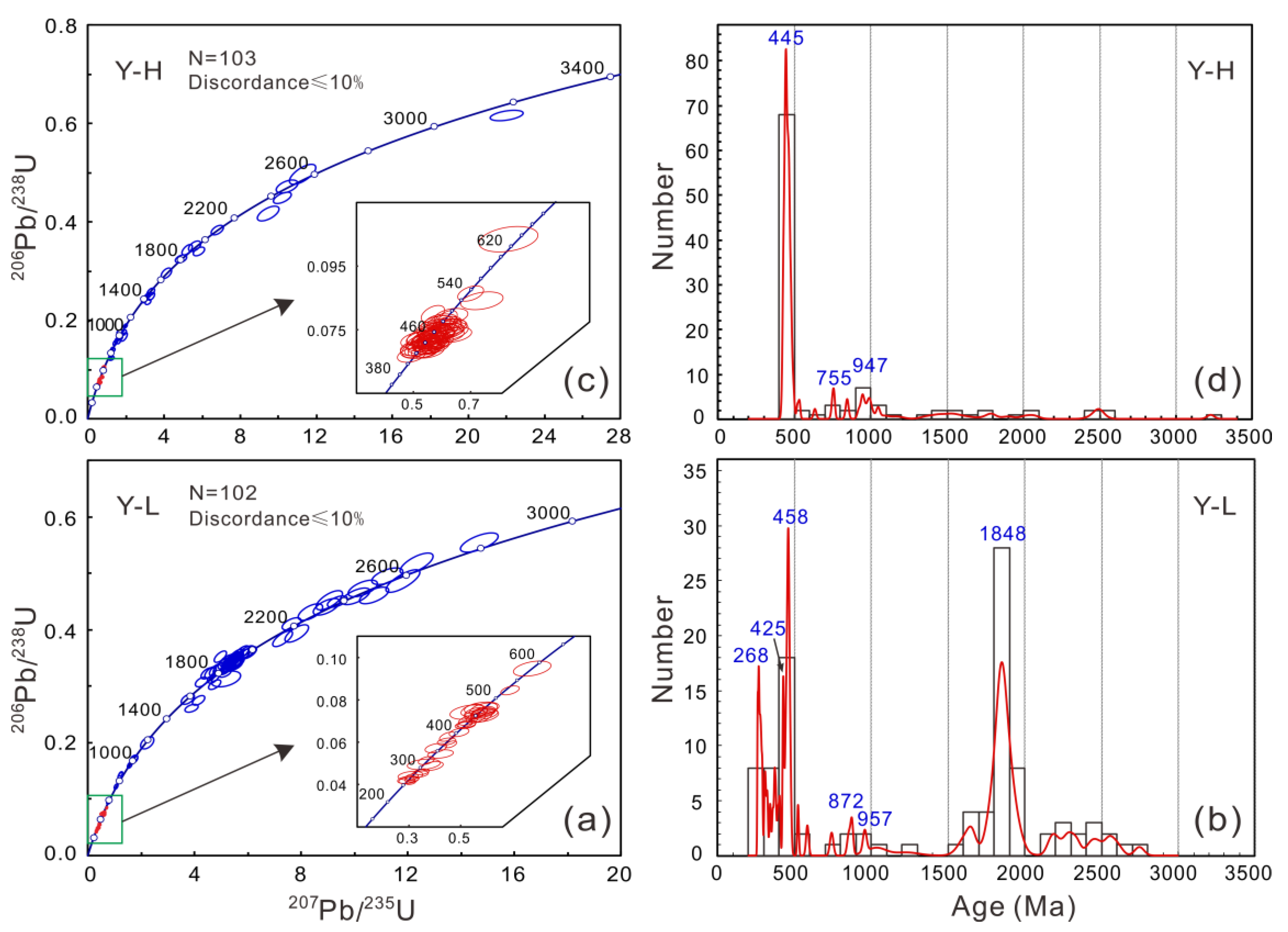
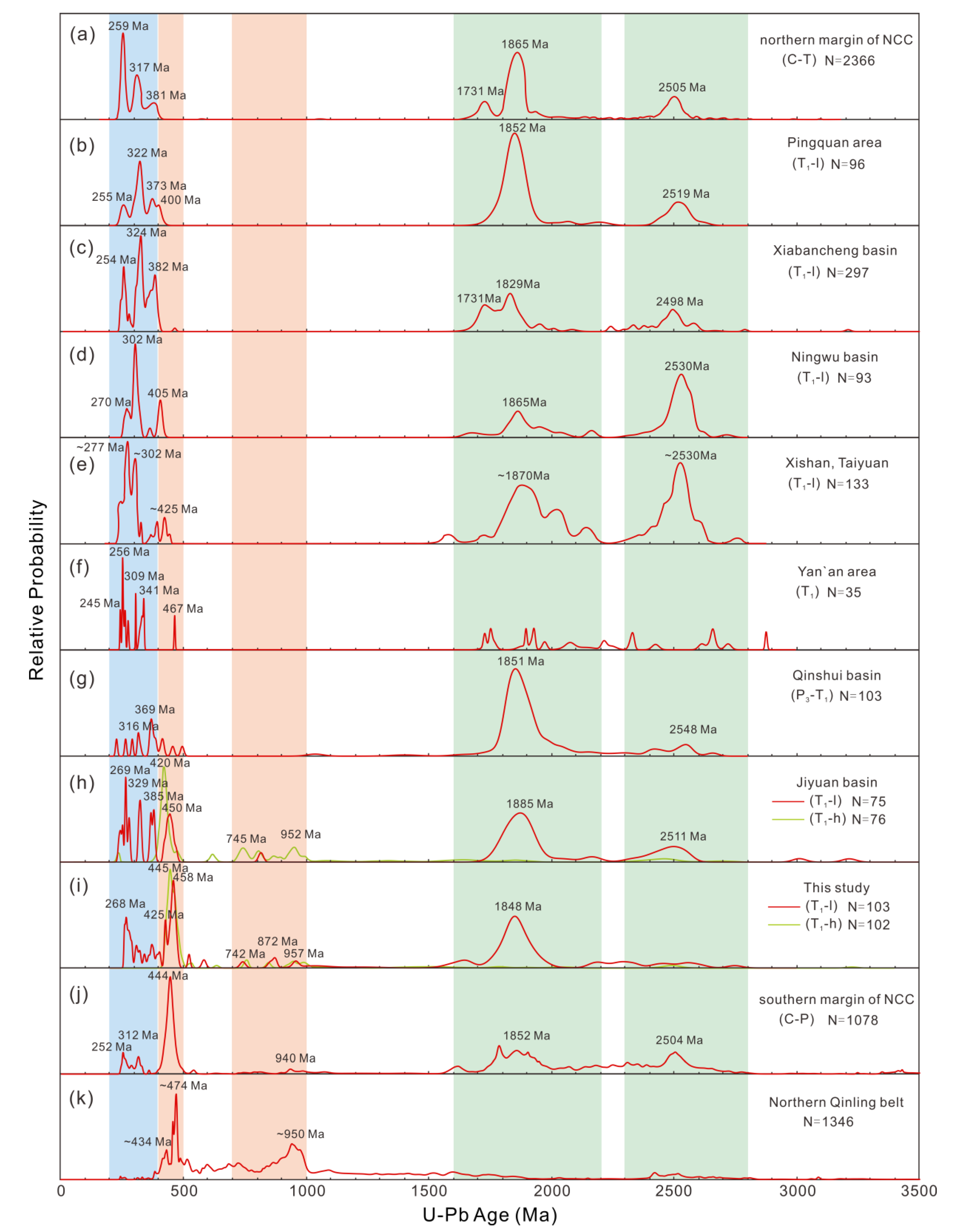
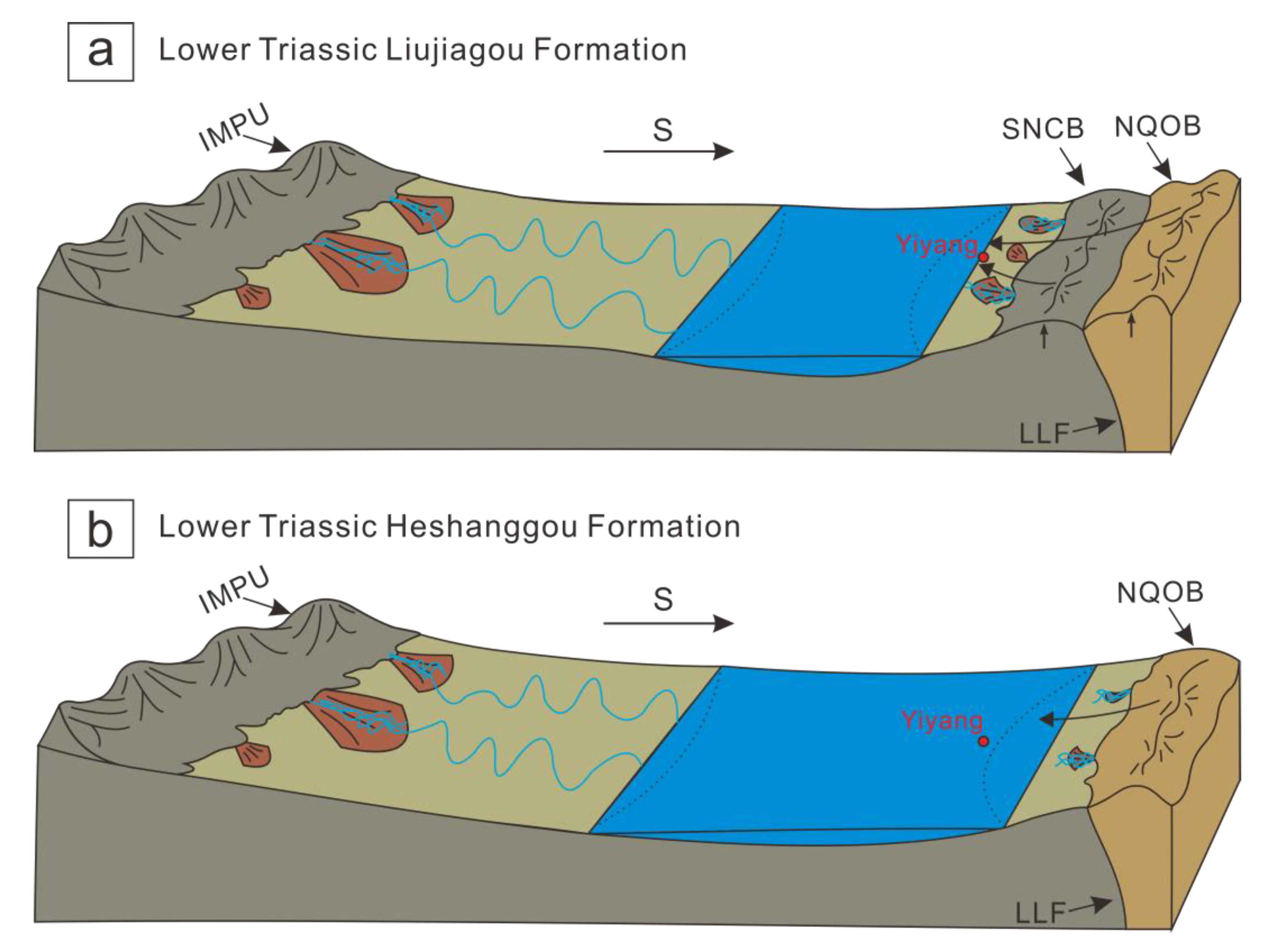
| Sample No. | Qm | Qp | Qt | P | K | F | Lv | Ls | L | Lt | Total |
|---|---|---|---|---|---|---|---|---|---|---|---|
| Liujiagou Formation | |||||||||||
| BL01 | 326 | 13 | 339 | 5 | 10 | 15 | 2 | 40 | 42 | 55 | 396 |
| BL02 | 288 | 12 | 300 | 1 | 5 | 6 | 0 | 36 | 36 | 48 | 342 |
| BL04 | 348 | 14 | 362 | 7 | 10 | 17 | 2 | 11 | 13 | 27 | 392 |
| BL05 | 333 | 11 | 344 | 5 | 5 | 10 | 0 | 23 | 23 | 34 | 377 |
| BL06 | 303 | 13 | 316 | 3 | 4 | 7 | 1 | 24 | 25 | 38 | 348 |
| BL07 | 359 | 27 | 386 | 1 | 4 | 5 | 2 | 24 | 26 | 53 | 417 |
| BL08 | 295 | 29 | 324 | 1 | 1 | 2 | 1 | 29 | 30 | 59 | 356 |
| BL09 | 266 | 22 | 288 | 1 | 1 | 2 | 0 | 26 | 26 | 48 | 316 |
| BL10 | 272 | 24 | 296 | 1 | 5 | 6 | 1 | 26 | 27 | 51 | 329 |
| BL11 | 298 | 15 | 313 | 2 | 9 | 11 | 0 | 19 | 19 | 34 | 343 |
| Heshanggou Formation | |||||||||||
| BH01 | 275 | 23 | 298 | 2 | 10 | 12 | 0 | 37 | 37 | 60 | 347 |
| BH02 | 269 | 20 | 289 | 3 | 8 | 11 | 1 | 50 | 51 | 71 | 351 |
| BH03 | 262 | 50 | 312 | 3 | 2 | 5 | 1 | 36 | 37 | 87 | 354 |
| BH04 | 278 | 27 | 305 | 2 | 4 | 6 | 1 | 55 | 55 | 82 | 366 |
| BH05 | 264 | 33 | 297 | 8 | 10 | 18 | 1 | 56 | 57 | 90 | 372 |
| BH07 | 272 | 33 | 305 | 8 | 7 | 15 | 0 | 29 | 29 | 62 | 349 |
| BH08 | 288 | 11 | 299 | 17 | 26 | 43 | 0 | 14 | 14 | 25 | 356 |
© 2019 by the authors. Licensee MDPI, Basel, Switzerland. This article is an open access article distributed under the terms and conditions of the Creative Commons Attribution (CC BY) license (http://creativecommons.org/licenses/by/4.0/).
Share and Cite
Wang, Y.; Yang, W.; Peng, S.; Qi, S.; Zheng, D. Early Triassic Conversion from Source to Sink on the Southern Margin of the North China Craton: Constraints by Detrital Zircon U-Pb Ages. Minerals 2020, 10, 7. https://doi.org/10.3390/min10010007
Wang Y, Yang W, Peng S, Qi S, Zheng D. Early Triassic Conversion from Source to Sink on the Southern Margin of the North China Craton: Constraints by Detrital Zircon U-Pb Ages. Minerals. 2020; 10(1):7. https://doi.org/10.3390/min10010007
Chicago/Turabian StyleWang, Yanpeng, Wentao Yang, Shenyuan Peng, Shuaishuai Qi, and Deshun Zheng. 2020. "Early Triassic Conversion from Source to Sink on the Southern Margin of the North China Craton: Constraints by Detrital Zircon U-Pb Ages" Minerals 10, no. 1: 7. https://doi.org/10.3390/min10010007
APA StyleWang, Y., Yang, W., Peng, S., Qi, S., & Zheng, D. (2020). Early Triassic Conversion from Source to Sink on the Southern Margin of the North China Craton: Constraints by Detrital Zircon U-Pb Ages. Minerals, 10(1), 7. https://doi.org/10.3390/min10010007





